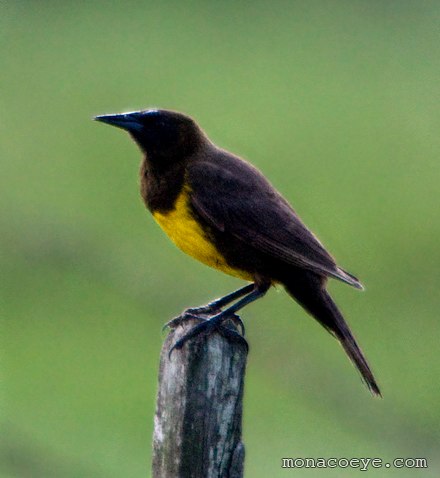I just returned from Puerto Vallarta, Mexico where I saw a bird that I can’t ID. It was all black and similar in size to the numerous Grackles in the area, but I was so shocked when it flew toward me… it displayed wide swaths of vivid yellow down the center of the under-wings and under-tail. So far, all the on-line bird guides want me to believe I saw a red winged blackbird or a grosbeak. I am very familiar with both and can say with certainty that it is not either one. The bird I saw was a bit larger than both of those and was solid black with no markings and the bright yellow is only visible on the underside during flight while the wings and tail are fanned out. Any ideas?
Any one turn on the Colibri signal?
Could it have been one of the cacique species?
I love this board. Where else could a question about identifying a bird be answered by someone named jayjay? ![]()
![]()
jayjay, thanks for the great effort, but that’s not it. The bird I saw had no yellow showing at all until it flew toward me and I could see underneath. The entire top was black and even the yellow on the underside of the tail didn’t show unless it was in flight. Thanks again

I am quite sure this is what you saw . . .
http://t0.gstatic.com/images?q=tbn:ANd9GcQwOkAC2DX6ZRjmotN_O9rQW2nBb8pFuxPGHKX4Zm6TPwT9CLJN
If it wasn’t a Yellow-winged Cacique, then I don’t know what it was. I just went through the Mexican field guide and there isn’t any bird that fits your description. Female and immature caciques are duller than the male but as far as I can tell would still show some yellow above.
Sorry for not responding sooner, but I was away last week on a birding trip to Nicaragua.
What were the highlights? (Having never been near there, it would probably be 100% highlights to me.)
I’ve birded most of the other countries of Central America, so there wasn’t too much that was new for me. We were mostly in the northeast of the country.
The highlights were:
-
ALesser Ground Cuckoo perched and calling in a thorn tree near Las Penitas. Usually secretive and difficult to see.
-
A Rufous-necked Wood-Rail in mangroves in the same area. Rare and usually extremely furtive; this was the fifth Nicaraguan record.
-
A female Nicaraguan Grackle at Lake Managua. A very narrow endemic mainly restricted to Nicaragua.
Thanks for the help, but I’m just not sure what to make of this bird I saw. It was hopping around in the tops of the palm trees and down on the grass with several other “black” birds. They seemed to be going after small insects. I watched them for several minutes, not really noticing any differences among them until one flew from the ground to the top of a palm. It landed about 6 feet from me. I was on a 5th floor balcony. It began what appeared to be a fight with another bird, going at each other with their feet and wings flapping. This only lasted for a few seconds, but that is when we saw the yellow under the wings and the tail. As soon as the commotion quieted the bird in question happily hopped around the tree with the others and you could not tell them apart. They looked like blackbirds with long tails. As far as we could tell, there were only 2 of these blackbirds with yellow markings in the entire group of 8-10.
No, but thanks 
Impressive.
I’m at a hotel in Puerto Vallarta right now also and just had the exact same question.
http://en.wikipedia.org/wiki/Great_kiskadee
The bird I saw was blacker than the bird in the picture, but based on the description (noisy, opportunistic with food crumbs, does well in urban areas) I’m almost certain this what I saw.
Welcome to the board! You may not have noticed that the question asked is almost two years old, so you might not get a response from the OP.
But I’m going to forward this thread to my sister who is an evid birder.
Given that the bird in the OP was described as being almost all black with some yellow, it very certainly was not a Great Kiskadee. You may have seen a Kiskadee, but that’s not what the OP saw.
Colibre, slight hijack here. I often have problems discerning color becuase of lighting issues but have gotten pretty good at picking up on slight flickerings and body movements. Is this considered an important tool in bird watching? Sometimes I feel like a can say I can name that bird in 1 flitter. Fact is I can recognise the bird but often don’t know the porper name.
A bit late with the obvious response, but anyway: Where else could a question about identifying a bird (often, actually) be answered by someone named Colibri?
